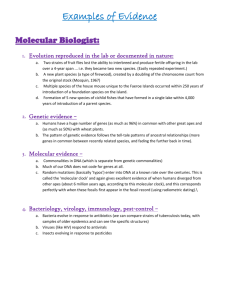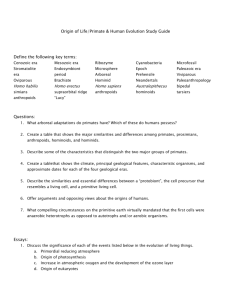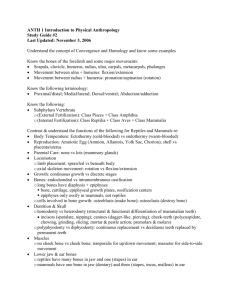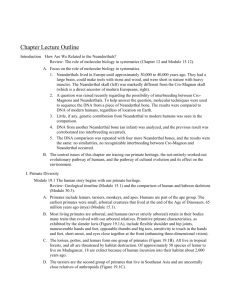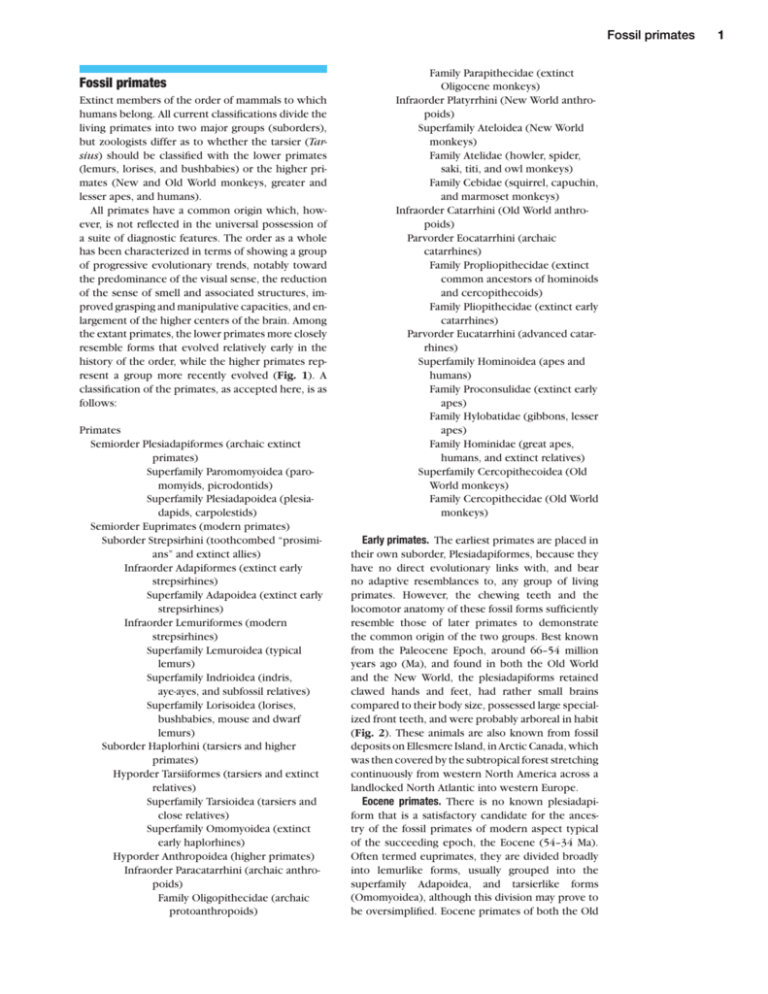
Fossil primates
Fossil primates
Extinct members of the order of mammals to which
humans belong. All current classifications divide the
living primates into two major groups (suborders),
but zoologists differ as to whether the tarsier (Tarsius) should be classified with the lower primates
(lemurs, lorises, and bushbabies) or the higher primates (New and Old World monkeys, greater and
lesser apes, and humans).
All primates have a common origin which, however, is not reflected in the universal possession of
a suite of diagnostic features. The order as a whole
has been characterized in terms of showing a group
of progressive evolutionary trends, notably toward
the predominance of the visual sense, the reduction
of the sense of smell and associated structures, improved grasping and manipulative capacities, and enlargement of the higher centers of the brain. Among
the extant primates, the lower primates more closely
resemble forms that evolved relatively early in the
history of the order, while the higher primates represent a group more recently evolved (Fig. 1). A
classification of the primates, as accepted here, is as
follows:
Primates
Semiorder Plesiadapiformes (archaic extinct
primates)
Superfamily Paromomyoidea (paromomyids, picrodontids)
Superfamily Plesiadapoidea (plesiadapids, carpolestids)
Semiorder Euprimates (modern primates)
Suborder Strepsirhini (toothcombed “prosimians” and extinct allies)
Infraorder Adapiformes (extinct early
strepsirhines)
Superfamily Adapoidea (extinct early
strepsirhines)
Infraorder Lemuriformes (modern
strepsirhines)
Superfamily Lemuroidea (typical
lemurs)
Superfamily Indrioidea (indris,
aye-ayes, and subfossil relatives)
Superfamily Lorisoidea (lorises,
bushbabies, mouse and dwarf
lemurs)
Suborder Haplorhini (tarsiers and higher
primates)
Hyporder Tarsiiformes (tarsiers and extinct
relatives)
Superfamily Tarsioidea (tarsiers and
close relatives)
Superfamily Omomyoidea (extinct
early haplorhines)
Hyporder Anthropoidea (higher primates)
Infraorder Paracatarrhini (archaic anthropoids)
Family Oligopithecidae (archaic
protoanthropoids)
Family Parapithecidae (extinct
Oligocene monkeys)
Infraorder Platyrrhini (New World anthropoids)
Superfamily Ateloidea (New World
monkeys)
Family Atelidae (howler, spider,
saki, titi, and owl monkeys)
Family Cebidae (squirrel, capuchin,
and marmoset monkeys)
Infraorder Catarrhini (Old World anthropoids)
Parvorder Eocatarrhini (archaic
catarrhines)
Family Propliopithecidae (extinct
common ancestors of hominoids
and cercopithecoids)
Family Pliopithecidae (extinct early
catarrhines)
Parvorder Eucatarrhini (advanced catarrhines)
Superfamily Hominoidea (apes and
humans)
Family Proconsulidae (extinct early
apes)
Family Hylobatidae (gibbons, lesser
apes)
Family Hominidae (great apes,
humans, and extinct relatives)
Superfamily Cercopithecoidea (Old
World monkeys)
Family Cercopithecidae (Old World
monkeys)
Early primates. The earliest primates are placed in
their own suborder, Plesiadapiformes, because they
have no direct evolutionary links with, and bear
no adaptive resemblances to, any group of living
primates. However, the chewing teeth and the
locomotor anatomy of these fossil forms sufficiently
resemble those of later primates to demonstrate
the common origin of the two groups. Best known
from the Paleocene Epoch, around 66–54 million
years ago (Ma), and found in both the Old World
and the New World, the plesiadapiforms retained
clawed hands and feet, had rather small brains
compared to their body size, possessed large specialized front teeth, and were probably arboreal in habit
(Fig. 2). These animals are also known from fossil
deposits on Ellesmere Island, in Arctic Canada, which
was then covered by the subtropical forest stretching
continuously from western North America across a
landlocked North Atlantic into western Europe.
Eocene primates. There is no known plesiadapiform that is a satisfactory candidate for the ancestry of the fossil primates of modern aspect typical
of the succeeding epoch, the Eocene (54–34 Ma).
Often termed euprimates, they are divided broadly
into lemurlike forms, usually grouped into the
superfamily Adapoidea, and tarsierlike forms
(Omomyoidea), although this division may prove to
be oversimplified. Eocene primates of both the Old
1
2
Fossil primates
STREPSIRHINI
Lemuridae
Indriidae
Daubentoniidae
TARSIIFORMES
Lorisidae
Tarsiidae
ANTHROPOIDEA
Cebidae
Atelidae
Cercopithecidae
Hylobatidae
Hominidae
Fig. 1. Representatives of living primate families.
and New Worlds already display the trends that mark
modern primates as a whole: These arboreal animals
possessed grasping hands and feet in which sharp
claws were replaced by flat nails backing sensitive
pads; the snout was reduced, suggesting a deemphasis of smell, while the bone-ringed eyes faced more
forward, producing stereoscopic vision and suggesting primary reliance on the sense of sight; and the
brain was somewhat enlarged relative to body size
when compared to those of other mammals of the
period.
It is possible that the origins of some specific
groups of extant lower primates may be traced back
to or through certain known primate genera of the
Eocene. Even if this is not the case, however, it is
universally accepted that the antecedents of these
living forms are to be sought somewhere within the
Eocene primate radiation, though the details of this
ancestry may remain unclear. In North America and
Europe, lower primates had nearly disappeared by
the close of the Eocene, while virtually all known
fossil lower primates of later epochs in Africa and
10 cm
Fig. 2. Reconstructed skeleton of Plesiadapis tricuspidens, a Eurasian plesiadapiform from about 60 Ma. Known parts are
shaded.
Fossil primates
Asia are closely related to modern primates of these
areas.
Modern lower primates. The extant lower primates
are allocated to the suborder Prosimii if Tarsius is included, and to the suborder Strepsirhini if this strange
primate is excluded, as is provisionally done here. All
extant strepsirhines possess dental scrapers (toothcombs), in which the lower front teeth are elongated, closely approximated, and forwardly projecting. These specialized structures are used both in
feeding and in social grooming. Additionally, all living
strepsirhines retain a moist, naked rhinarium (wet
nose, as in a dog) and related structures, reflecting a
greater reliance on the sense of smell than is typical
of higher primates. All are also united by possessing
a toilet claw (used for self-cleaning) on the second
digit of the foot. Although all strepsirhines possess
grasping hands and feet, their manual dexterity is
generally inferior to that of higher primates; their
brains are also relatively small.
There is no ancient primate fossil record in Madagascar, home of the most diverse group of modern
lower primates, but extinct species little more than
a thousand years old document a much wider adaptive radiation before the arrival of humans on the
island. Notable among those extinct lemurs are
Paleopropithecus, a large-bodied climber-hanger
somewhat like the orangutan in its locomotion
(Fig. 3); the semiterrestrial and dentally specialized
members of the subfamily Archaeolemurinae, related
to the living indriids but adapted somewhat like baboons; and Megaladapis, a very large, vertically
postured, short-limbed, and probably slow-moving
climber with adaptive resemblances to the koala
of Australia. Fragmentary remains of lorisoid strepsirhines are known from the Miocene of East Africa
and Pakistan.
Tarsiers. The tiny Tarsius, which lives today in
Southeast Asia, represents a link between the toothcombed strepsirhines and the anthropoids (monkeys, apes, and humans). In many respects (such as
lack of toothcomb, dry nasal area, molecular biology,
and placentation), it is related to the anthropoids,
but dentally it is usually thought primitive, although
some authors have found similarities to some strepsirhines. The extinct Eocene omomyoids are close to
tarsiers skeletally; they are often considered broadly
ancestral to the anthropoids for that reason and also
because some have monkeylike front teeth. A tarsierlike fossil has been recovered in Egypt from deposits
of early Oligocene age (35 Ma). Living tarsiers eat insects and small vertebrates, and are vertical clingers
and leapers; their nocturnal habit is shown by their
relatively huge eyes. They appear to live mainly in
pairs, but they may form larger associations in some
regions.
Higher primates. The anthropoids include three
main groups of living animals and their extinct relatives; their divergence from a possibly omomyoid
stock probably took place some 50 Ma. The monkeys
of the New World and those of the Old are of similar evolutionary grade, but the latter share a much
20 cm
Fig. 3. Anjohibe specimen of Paleopropithecus ingens, mounted in probable habitat
posture. (Photo courtesy of American Geological Institute)
more recent common ancestry with apes and humans, with which they are grouped in the infraorder
Catarrhini.
The earliest known anthropoids may be represented by a few teeth (of Algeripithecus) from
Algeria about 45 million years old, but betterpreserved forms appear in the Fayum region of Egypt
between 35 and 33 Ma. Although now a desert, at the
time this was a lush tropical forest through which
meandered the sluggish proto-Nile river. Three main
groups of early higher primates are represented: the
oligopithecids, the parapithecids, and the propliopithecids. The former two appear to be only distantly
related to any of the living monkeys or apes, although
they may be termed monkeys in the broad sense, as
their adaptations are similar to those of modern monkeys. The propliopithecids (species of Propliopithecus, including Aegyptopithecus) may be close to the
common ancestry of later catarrhines (Old World anthropoids). These arboreal animals were the size of
small cats, with apelike teeth, small brain, and limbs
similar to those of the acrobatic South American
atelines. Representatives of modern lineages begin to
occur in the fossil record by about 28–20 Ma in both
hemispheres. Most scholars subscribe to a colonization of South America by Fayum-age African anthropoids that crossed a then-narrower South Atlantic
ocean on rafts of natural vegetation to reach the isolated island continent.
New World primates. The platyrrhine or ateloid
monkeys of South and Central America are divided
into two families, of which the contents vary according to author. All living (and well-known extinct)
forms are arboreal and occupy forested areas between Argentina and southern Mexico. A distinctive
3
4
Fossil primates
evolutionary pattern observed in this group is the antiquity of the extant lineages as reflected by the close
relationships of most of the few known fossils to
modern genera. The small marmosets and the common squirrel and capuchin monkeys are grouped
into the family Cebidae, while the generally largebodied spider-howler and saki-uakari groups are
linked to the smaller titis and (probably) owl monkeys in the Atelidae. These two families differ in the
relative robustness of their jaws and reduction of last
molars.
The earliest fossil platyrrhine, 26-million-year-old
Branisella from Bolivia, is as yet known only by
teeth and jaw fragments. A probable size reduction
of its last molars may suggest an evolutionary relationship to the Cebidae. It has also been suggested
that Branisella might have lived in a savannahlike
environment and been adapted to life at least partly
on the ground, as opposed to all later platyrrhines.
Two slightly later (about 20 Ma) species from Patagonia and Chile are also probable cebids, close to the
ancestry of the living Saimiri, and several forms of
18–17 Ma represent early atelids, close to the living pitheciines (the saki-uakari and titi-owl monkey
groups).
The largest number of fossil platyrrhines comes
from the La Venta beds of Colombia, dated about
13 Ma. These include one or two species in each
subfamily of Cebidae (Callitrichinae and Cebinae),
one relative each of owl and howler monkeys, and
four early members of the saki-uakari group. The
last 100,000 years saw another flowering of extinct
platyrrhine lineages. A cave site in eastern Brazil has
yielded partial skeletons of “giant” relatives of the
howler and spider monkeys, while several localities
in the Caribbean produced controversial fossils perhaps related to howlers, saki-uakaris, and squirrel
monkeys (or possibly representing a distinct lineage
whose members came to resemble those other
groups). See MONKEY.
Old World monkeys. The living Cercopithecidae are
divided into two subfamilies, Colobinae and Cercopithecinae. The oldest cercopithecids are found in
Africa, with a few fossil forms such as Victoriapithecus of 20–15 Ma probably predating the divergence
of the modern subfamilies. The cercopithecines include a wide variety of forms, all of which share
cheek pouches for temporary food storage and usually large incisors reflecting a fruit diet; colobines, by
contrast, are more restricted in morphology, range,
and behavior pattern, and all are leaf eaters with
a complicated digestive tract to facilitate the lownutrition diet. All cercopithecids possess ischial callosities, or rump sitting pads, which have been lost
to a greater or lesser extent in apes and humans.
The earliest members of the two living subfamilies
also are mainly African. One colobine jaw is known
by 9 Ma, and from 7 to 5 Ma species of both cercopithecines and colobines become more abundant.
Large collections of Old World monkey fossils have
been recovered from East and South African sites
(often in association with early human remains) in
the 4–1.5 Ma interval. Cercopithecines are represented first by Parapapio, which was a semiterrestrial animal probably closer to the common ancestor
of later forms, and then by several species of the
highly terrestrial living Theropithecus. At least three
types of large colobine monkeys were also common,
ranging from arboreal to terrestrial in adaptation.
Many of these species were significantly larger than
~10 cm
Fig. 4. Reconstructed skeleton of Mesopithecus pentelicus, an 11- to 8-million-year-old colobine monkey. Known parts are
shaded. ( After A. Gaudry, Animaux Fossiles et Géologie de l’Attique, Savy, Paris, 1862)
Fossil primates
their living relatives: The biggest colobine may have
weighed close to 50 kg (110 lb), while a Theropithecus dated about 1 Ma has been estimated nearly twice
that large. Some of these large and slow-moving
species may have been hunted and perhaps driven
to extinction by early humans.
Cercopithecids entered Eurasia from Africa. Mesopithecus pentelicus, an 11- to 8-million-year-old colobine known in a geographical range from Germany
through Afghanistan, is the best-represented Eurasian
fossil monkey, with dozens of individuals recovered
from sites in Greece (Fig. 4). It was semiterrestrial,
perhaps like the living hanuman langur Semnopithecus entellus, sleeping in trees and feeding on the
ground along watercourses. A possible descendant is
Dolichopithecus, which lived in Europe from about
4.5 to 2.5 Ma and perhaps in Mongolia and Siberia as
well. It was even more terrestrially adapted, more
so than any living colobine. The living macaques
(Macaca) are widespread across eastern Asia and in
North Africa, and their fossil record adds to that large
range. Scattered specimens are known from North
Africa after 7 Ma, and populations have been recovered across Europe from 5.5 Ma to about 100,000
years ago. A large and highly terrestrial relative,
Paradolichopithecus, inhabited Europe, central Asia,
and perhaps eastern Asia from about 3 to 1.5 Ma.
Hominoids. The most humanlike of all primates are
the apes, which form a group distinguished by
generally large body size, relatively large brain, lack
of an external tail, and advanced placentation pattern. Living forms include the lesser apes, or gibbons
(Hylobates), placed in their own family Hylobatidae,
and the several great apes: orangutan (Pongo), chimpanzee (Pan), and gorilla (Gorilla). The great apes
and humans, along with some extinct relatives, are
grouped as the Hominidae by some authors, while
others place only humans in the Hominidae and class
all great apes in the Pongidae.
One of the earliest probable members of Hominoidea is Proconsul, of the East African Miocene,
23–14 million years old; a few teeth of a similar form
date to 26 Ma. Proconsul is well known by most of
its skeleton (Fig. 5). Several species ranged in size
from small chimpanzee to small gorilla, with a somewhat chimplike skull, large projecting canine teeth,
and limb bones seemingly adapted to quadrupedal
running. However, Proconsul has few of the defining features of the ape group. It lacks the mobile
shoulder characteristic of all living species, and there
is some controversy over its tail: some workers believe that tail bones have been found but not always
recognized as such. For the present, Proconsul is
retained as a hominoid belonging to a distinct archaic family of its own. Two other groups of roughly
contemporaneous species (the Eurasian Pliopithecidae and the African “Dendropithecus-group”) are
clearly more “primitive” than Proconsul, although
they have at times wrongly been included in Hominoidea, usually as purported relatives of the gibbons.
The oldest fossil gibbons date only to about 1 Ma; presumably, their ancestors lived after Proconsul and
5
entered Eurasia about the same times as did early
Hominidae.
Several fossil apes from Africa dating to 20–14 Ma
are often placed in the Hominidae because they appear to share “advanced” dental features with the
modern great apes. But most of these species have
recently been questioned as hominids because they
lack apelike features of the postcranial skeleton (in
the elbow, shoulder, hip, and knee joints, especially).
Surprisingly, the oldest of these, Morotopithecus,
may be the most “modern,” although only fragmentary postcranial elements are known. The youngest,
Kenyapithecus, is similar to the first Eurasian hominoid, Griphopithecus, found in Turkey, Germany,
Slovakia, and Austria between 16 and 13 Ma. None of
these fossils are specially related to any living great
ape, and they are often placed in the hominid subfamily Kenyapithecinae or even outside Hominidae.
Although interpretations vary, there appear to be
three groups of Eurasian hominids between 13 and
7 Ma. Dryopithecus is characteristic of the Dryopithecinae, which may include the common ancestors of all later great apes (and humans). This animal
has been known since the 1850s, but only in the
1990s were partial crania and skeletons described.
These show several similarities to living apes in general but not to any specific forms.
Spread of modern ape ancestors. Most scientists
today agree that, of the great apes, the orangutan
is evolutionarily farthest from humans. This view is
~10 cm
Fig. 5. Reconstructed skeleton of Proconsul africanus, an early hominoid (23–14 Ma) from
East Africa. Known parts are shaded. ( After R. L. Ciochon and R. S. Corruccini, eds., New
Interpretations of Ape and Human Evolution, Plenum Press, 1983)
6
Fossil primates
based mainly on the results of numerous studies of
proteins and DNA sequences, which reveal great similarity among the genes of gorillas, chimpanzees, and
humans; and with orangutans, gibbons, and monkeys
successively farther from that close-knit group. As a
result, orangutans and their extinct relatives are here
placed in the subfamily Ponginae, while African apes,
humans, and their relatives are included in Homininae. The living orangutans (Pongo) inhabit a small
range in the deep forests of Borneo and Sumatra; less
than 1 Ma, the same species was also present as far
north as southern China. See APES.
The orangutan lineage is, however, the oldest welldocumented one among all catarrhines. Fossils from
Pakistan and India known as Sivapithecus show facial, palatal, and dental architectures clearly specialized in the orang direction as far back as 13–12 Ma.
Although slightly younger in time, Ankarapithecus
from Turkey at approximately 10 Ma appears intermediate between Sivapithecus and Dryopithecus in
facial morphology. These three genera seem to form a
transformation series representing the approximate
manner in which orang ancestry evolved from dryopithecines, and both Ankarapithecus and Sivapithecus are usually included in Ponginae. But whereas
the living great apes (and human ancestors) share a
complex of arm-bone features related to suspensory
behavior and forelimb flexibility, the upper arm of
Sivapithecus lacks at least one part of this complex.
Thus, it is possible either that this lack denies Sivapithecus close relationship with orangs or other apes,
or that Asian and African great apes independently
evolved these features long thought to document
their shared ancestry. However, the lack may merely
represent a secondary specialization of Sivapithecus
which happens to be (convergently) similar to more
archiac apes like the kenyapithecines. This last option makes sense, as Sivapithecus in other ways appears to be somewhat more adapted to quadrupedal
life on the ground than is the living orangutan.
Two larger species which probably belong to the
Ponginae are placed in the genus Gigantopithecus:
One dates to about 9–6 Ma from India and Pakistan,
the other lived about 1.5–0.5 Ma in China and
perhaps Vietnam. Hundreds of specimens, mostly
isolated teeth, are known from China, and these document a species which was probably the largest primate that ever lived (perhaps weighing 200–400 kg
or 440–880 lb, although teeth are not the best body
part from which to estimate weight). Gigantopithecus was once thought to be near the ancestry of humans, but today it is usually considered a collateral
descendant of Sivapithecus.
The pongines probably evolved in Asia from an
arboreal dryopithecine (or even kenyapithecine) ancestry which expanded into less forested environments. Such a habitat would have provided an
abundance of gritty and tough food objects, to
which this group’s dentition appears adapted. It was
at first thought that these creatures might have spent
significantly more time walking and feeding on the
ground than modern or earlier apes, but partial limb
bones suggest overall similarity of structure, and thus
probably of behavioral function, to living arboreal
and partly ground-living apes. They share with
orangutans and some early humans a complex of
dental-related features, including a thick molar
enamel covering (to prolong tooth life with heavy
wear), large molars in relation to estimated body size,
strongly buttressed jaws (to take up stresses of heavy
chewing), and some reorientation of the front teeth.
A major factor in human dental evolution was facial
shortening combined with reduction of the canine
teeth and their transformation into incisorlike elements, but no Miocene fossils yet known show this
feature clearly.
The origin of the Homininae is more problematic. The fossil ape Graecopithecus (also termed
Ouranopithecus) is known from several Greek localities estimated to date between 10 and 8 Ma. Wellpreserved facial material of this animal and of Dryopithecus recovered or reanalyzed in the 1990s has led
different workers to suggest that one or both forms
may lie near the split between Ponginae and Homininae or already on the hominine lineage, effectively
close to the common ancestor of African apes and humans. This would agree well with the date of about
13–12 Ma for the earliest pongines on the assumption
that both branches of the split would have developed
their derived features contemporaneously. Graecopithecus shows more evidence of the downwardly
bent face typical of African apes (a pattern termed
klinorhynchy) and also very thick molar enamel (as
expected in an early hominine), while Dryopithecus has thin enamel. Some of the differences between them may just reflect the far larger size of
Graecopithecus, but at present this genus appears
more derived in the direction of later hominines. At
about the same time in Africa, the only known ape
fossil is a single upper jaw which was named Samburupithecus in 1997 and which may also represent an
early, gorillalike member of Homininae. These fossils
imply that the hominines may have evolved in Eurasia
and then returned to Africa after about 10 Ma. Previous workers often thought that the hominine lineage could be traced purely within Africa, but that
hypothesis now appears less likely. The ancestry of
the African apes is still a mystery, as no fossils have
yet been found which clearly represent their lineage
before or after separation from humans.
Human evolution. After about 5 Ma, evidence for
the human clade is increasingly common. The name
Ardipithecus ramidus has been given to a small
group of fossils dated about 4.4 Ma at the site of
Aramis in the Awash Valley of Ethiopia. This species
appears to be the most conservative (“primitive”)
member of the Hominini, the lineage including living
humans but postdating the last common ancestors
of humans and other apes. Ardipithecus ramidus is
characterized by teeth which combine some apelike
morphology with reduced, incisiform canines, and
also by an anterior placement of the foramen magnum (through which the spinal cord connects to the
brain) indicating that the head was balanced atop
Fossil primates
the trunk in the manner of bipedal humans rather
than quadrupedal apes. A partial skeleton has been
recovered, but not described as of early 2001.
Several species of the genus Australopithecus are
known from sites dating between 4.2 and 2.3 Ma
in South Africa, Chad, and the Rift Valley from
Tanzania through Ethiopia. They have crania with
internal volumes (“brain size”) of 400–500 ml, in
the range of living gorillas; body weight, however,
is far smaller, about 30 kg for females, up to 60 kg for
males. The jaw musculature was small enough not
to require strong crests on the outer surface of the
skull. The dentition had moderately large incisors,
relatively small and partly incisivized canines, thickenameled molars, and a broadly “humanlike” arcade
shape. The postcranial skeleton was clearly adapted
to upright bipedalism (also indicated by footprint
trails), although it differed in detail from modern humans, with relatively short legs. The diet of
these forms was probably omnivorous, including
fruits, seeds, and perhaps scavenged animal protein; there is no evidence for toolmaking. See AUSTRALOPITHECINE.
The “robust” australopiths, genus Paranthropus,
were generally younger (about 2.6–1.4 Ma) and more
derived craniofacially. Their postcanine teeth were
greatly enlarged and adapted to crushing and grinding hard food items, while the canines and incisors
were strongly reduced except in the earliest species,
P. aethiopicus. Sagittal and nuchal crests served as
anchors for the large temporal musculature covering
a vault enclosing an only slightly larger brain than in
Australopithecus; the postcranial skeleton is poorly
known, but body structure and size were probably
not much different from that of its predecessor.
The earliest toolmakers probably belonged to
species included in the living genus Homo, first appearing 2.5–2.2 Ma in Malawi, Kenya, and Ethiopia,
soon after the oldest stone tools. There is some debate over the number of early Homo species, but it
seems likely that at least three were contemporaneous if not actual neighbors in eastern Africa around
2 Ma. Soon afterward, Homo erectus (or according
to some authors, a closely related species named H.
ergaster) emigrated from Africa to eastern Eurasia
where H. erectus persisted until at least 300 Ka
(thousand years ago). Continental Europe may not
have been colonized until about 1 Ma; almost all
younger populations there appear to be part of a
lineage which led eventually to the Neanderthals,
most common from 200 to 30 Ka between Spain
and central Asia. African populations of the last half
million years evolved less directly into anatomically
modern humans (Homo sapiens sapiens), some of
whom dispersed via southwestern Asia to colonize
the rest of the Earth after 150 Ka. See FOSSIL HUMANS;
MAMMALIA.
Eric Delson; Ian Tattersall
Bibliography. D. R. Begun, C. V. Ward, and M. D.
Rose (eds.), Miocene Hominoid Fossils: Functional
and Phylogenetic Implications, 1997; E. Delson
et al. (eds.), Encyclopedia of Human Evolution and
Prehistory, 2d ed., 1999; J. G. Fleagle, Primate Adaptation and Evolution, 2d ed., 1998; R. F. Kay
et al. (eds.), Vertebrate Paleontology in the Neotropics, 1997; R. F. Kay, C. Ross, and B. A. Williams, Anthropoid origins, Science, 275:789–804, 1996; C.-B.
Stewart and T. Disotell, Primate evolution—in and
out of Africa, Curr. Biol., 8:R582–R588, 1998; F. S.
Szalay and E. Delson, Evolutionary History of the
Primates, 1979.
Reprinted from the McGraw-Hill Encyclopedia of
c 2002 by
Science & Technology, 9th Edition. Copyright The McGraw-Hill Companies, Inc. All rights reserved.
7



